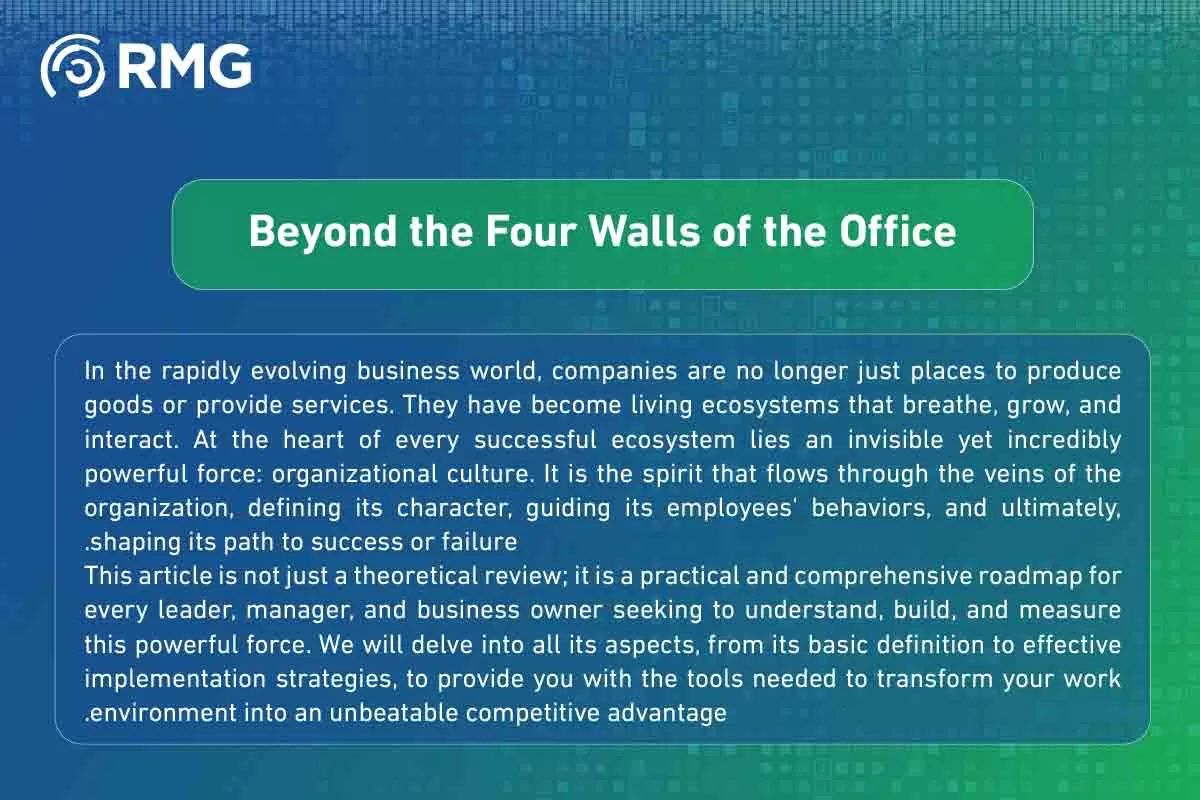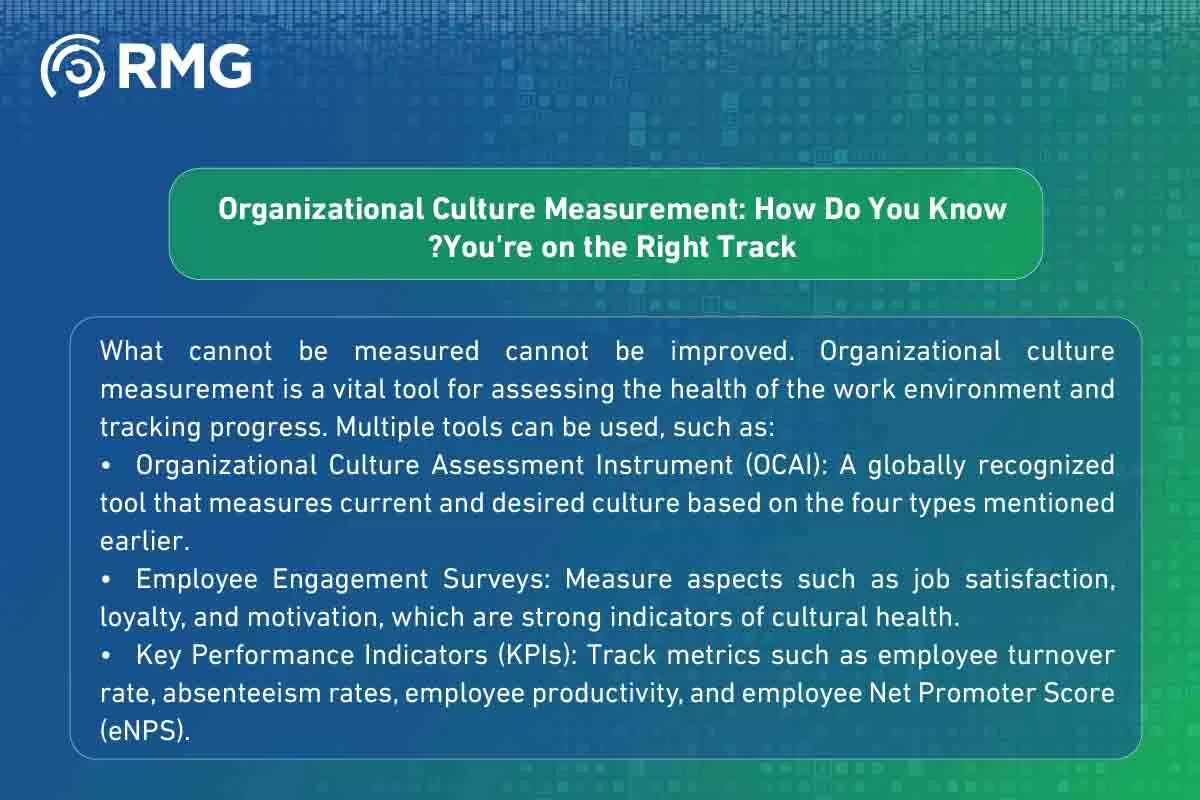Blog Body
Have you ever wondered what the hidden force is that propels giant companies to the top? It’s not just the product or service; it’s “organizational culture.” Discover with us how to create a strong culture that attracts top talent, fosters innovation, and achieves sustainable growth for your organization.
Beyond the Four Walls of the Office
In the rapidly evolving business world, companies are no longer just places to produce goods or provide services. They have become living ecosystems that breathe, grow, and interact. At the heart of every successful ecosystem lies an invisible yet incredibly powerful force: organizational culture. It is the spirit that flows through the veins of the organization, defining its character, guiding its employees’ behaviors, and ultimately, shaping its path to success or failure.
This article is not just a theoretical review; it is a practical and comprehensive roadmap for every leader, manager, and business owner seeking to understand, build, and measure this powerful force. We will delve into all its aspects, from its basic definition to effective implementation strategies, to provide you with the tools needed to transform your work environment into an unbeatable competitive advantage.
What is the Definition of Organizational Culture?
Before diving into the details, we must lay a solid foundation. Organizational Culture is simply the shared set of values, beliefs, norms, behaviors, and practices that shape an organization’s character and distinguish it from others. It is “the way we do things around here.” This culture is not always written in employee handbooks; rather, it is lived daily in meeting rooms, in the way colleagues communicate, in the style of decision-making, and in how successes are celebrated and failures are handled. It is the social DNA that binds the organization’s members together towards a common goal.
The Importance of Organizational Culture: Why Is It the Cornerstone of Your Success?
Some may see it as a soft concept or a luxury, but the importance of Organizational Culture lies in its direct and measurable impact on an organization’s performance. It’s not just a “good feeling”; it’s a powerful strategic tool that achieves the following:
- Attracting and Retaining Talent: Companies with positive and renowned cultures, like Google or Netflix, act as magnets for the best talent in the market.
- Boosting Loyalty and Employee Retention: When employees feel a sense of belonging and appreciation, employee turnover significantly decreases, saving recruitment and training costs.
- Increasing Productivity and Performance: A work environment that encourages collaboration, trust, and transparency motivates employees to give their best.
- Stimulating Innovation and Creativity: A culture that embraces risk and rewards new ideas creates a fertile ground for innovation, ensuring the company’s continued competitiveness.
- Enhancing Brand Reputation: Internal culture inevitably reflects on the external customer experience. Happy employees provide better service, which builds a strong company reputation.
The Impact of Organizational Culture on Organizations: From Theory to Reality
The impact of organizational culture on organizations goes far beyond employee morale. A strong and positive culture can be the difference between rapid growth and stagnation. For example, a “customer-first” culture will ensure that every decision made, from product development to after-sales service, serves the customer’s best interests, leading to increased customer satisfaction and loyalty. In contrast, a toxic culture dominated by fear, blame, and internal politics can destroy creativity, stifle productivity, and lead to a significant talent drain, endangering the entire organization.
Types of Organizational Culture: Which Personality Suits Your Company?
There is no one-size-fits-all when it comes to culture. Based on the popular OCAI (Organizational Culture Assessment Instrument) model, organizational culture types can be classified into four main models:
- Clan Culture: Resembles a large family. It focuses on collaboration, teamwork, and employee development. Loyalty and tradition are its foundation.
- Adhocracy Culture: A dynamic and entrepreneurial environment. It focuses on innovation, risk-taking, and being at the forefront of the market. It encourages freedom and experimentation.
- Market Culture: Strictly focuses on results. Competition and achieving goals are the main drivers. Success is measured by market share and profits.
- Hierarchy Culture: An organized and procedure-driven environment. It focuses on efficiency, stability, and smooth operations. Rules and policies guide the work.
Understanding these types helps leaders identify their current cultural personality and the one they aspire to achieve.
Examples of Organizational Culture from Global Companies
To illustrate these types, here are examples of organizational culture from industry giants:
- Google: A classic example of an Adhocracy Culture mixed with a Clan Culture. It is known for its innovative environment, amazing employee perks, and encouragement of side projects (20% policy).
- Zappos: A perfect model of a Clan Culture centered on customer service. Its ten core values, including “creating fun and a little weirdness,” are an integral part of its identity.
Levels of Organizational Culture: Uncovering the Hidden Layers
According to Edgar Schein, one of the most prominent theorists in this field, the levels of organizational culture consist of three interconnected layers, resembling an iceberg:
- Artifacts: The visible part of the culture. This includes office design, dress code, logos, circulating stories, and language used. This is the tip of the iceberg.
- Espoused Values: The goals, strategies, and philosophies officially declared by the company. These are the principles the company says it believes in.
- Basic Underlying Assumptions: The deepest and most hidden level. These are the ingrained, unconscious beliefs and convictions that truly guide employee behavior. This is the submerged part of the iceberg and the most powerful in its influence.
Dimensions of Organizational Culture: Analyzing Your Company’s DNA
To understand a culture more deeply, its components must be analyzed. The dimensions of organizational culture are a set of characteristics upon which an organization can be evaluated, the most important of which include:
- Innovation and Risk-Taking: The extent to which employees are encouraged to experiment and take calculated risks.
- Attention to Detail: The degree of precision and analysis required by the work.
- Outcome Orientation: The extent to which management focuses on outputs and goals rather than processes.
- People Orientation: The extent to which management decisions consider their impact on employees.
- Team Orientation: The extent to which work is organized around teams rather than individuals.
- Aggressiveness/Competitiveness: The degree of competitiveness among employees.
- Stability: The extent to which activities focus on maintaining the status quo versus growth.
Factors Influencing Organizational Culture
Culture is not something that appears out of nowhere. Several factors influencing organizational culture constantly shape and refine it, most notably:
- Leadership: Leaders and founders are the primary architects of culture. Their behavior, values, and decisions set the tone for everyone.
- Industry: The culture of a tech startup will inevitably differ from that of a well-established investment bank.
- Geographical Environment and National Culture: Prevailing societal values directly influence the work environment.
- Organization’s History and Major Events: The successes, failures, and crises the company has experienced leave lasting imprints on its culture.
Organizational Culture of Companies and How to Identify It
Understanding and shaping the organizational culture of companies and how to identify it is the first step towards improvement. You can start by:
- Observing and Listening: Notice how employees interact, what stories they tell, and who the heroes are within the company.
- Conducting Surveys and Interviews: Directly ask employees about the values they see in practice, and what motivates or discourages them.
- Analyzing Processes and Policies: Examine reward and promotion systems. Do they reward the behaviors you want to foster?
- Identifying the Gap: Compare the current culture (as it is in reality) with the desired culture (which you aspire to).
Organizational Culture Measurement: How Do You Know You’re on the Right Track?
What cannot be measured cannot be improved. Organizational culture measurement is a vital tool for assessing the health of the work environment and tracking progress. Multiple tools can be used, such as:
- Organizational Culture Assessment Instrument (OCAI): A globally recognized tool that measures current and desired culture based on the four types mentioned earlier.
- Employee Engagement Surveys: Measure aspects such as job satisfaction, loyalty, and motivation, which are strong indicators of cultural health.
- Key Performance Indicators (KPIs): Track metrics such as employee turnover rate, absenteeism rates, employee productivity, and employee Net Promoter Score (eNPS).
Renad Al Majd: Your Strategic Partner in Building an Exceptional Organizational Culture
Building a strong organizational culture is not an easy task; it is a strategic journey that requires expertise and vision. This is where Renad Al Majd (RMG) comes in. We do not see culture as a secondary element but as the most valuable asset in any organization. We believe that technology and human strategies must work together to create inspiring and productive work environments.
At Renad Al Majd, we help you transition from merely talking about culture to effectively implementing it. We understand that every organization is unique, which is why we offer customized solutions that align with your vision and strategic goals.
Renad Al Majd Services: How We Help You Enhance Organizational Culture?
At Renad Al Majd, we offer a comprehensive package of consulting and technical services specifically designed to diagnose, develop, and enhance organizational culture in your institution. Our services include:
- Cultural Diagnosis and Assessment: We use global measurement tools and in-depth interviews to identify strengths and weaknesses in your current culture and draw a clear roadmap for improvement.
- Culture Building Workshops and Strategies: We work with your leadership team to define core values and design concrete strategies to embed them in all aspects of work.
- Leadership Development: We train and qualify leaders to be ambassadors of the desired culture, capable of inspiring and guiding their teams.
- Performance Management and Reward Systems: We help you design systems that reward and reinforce behaviors that serve your new culture, ensuring alignment of individual and organizational goals.
- Change Management Solutions: We provide the necessary support to ensure a smooth and effective transition to the new culture, focusing on transparent communication and employee engagement.
Call to Collaborate:
Don’t leave the success of your organizational culture to chance. It is your best investment in your future. Contact Renad Al Majd’s experts today to embark together on a journey to transform your work environment into a driving force for excellence and sustainable growth.
















